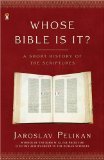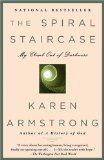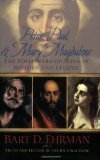Lee Harmon's Blog, page 129
May 15, 2011
Book review: Whose Bible Is It?
 by Jaroslav Pelikan
by Jaroslav Pelikan★★★★★
It's been maybe a year since I read this book, but I recently dug it out again for a bit of research. I was looking into the Comma Johanneum, that controversial little verse in the first epistle of John that got a facelift in the Middle Ages: http://www.dubiousdisciple.com/2011/03/1-john-57-8-comma-johanneum.html .
In this book, Pelikan discusses how the Bible came to be, how it was interpreted through the ages, and how Christianity built its own message atop the Tanakh (the Torah, the prophets, and the Writings). But the Bible didn't stop growing 2,000 years ago; it continues to be interpreted, modified, translated through the ages.
Did Christianity steal the Bible from the Jews? Pelikan has a way of uniting Christian and Jew even while recognizing an impenetrable rift. His writing is wonderfully readable and occasionally funny, as he points out how contradictory religions can read the same words and be inspired in different ways. He sees diversity as something to be appreciated, not condemned.
One cannot help but appreciate the Bible more as a living, growing, entity after reading this. The Word is alive! And ultimately, in the search for who owns the Bible, we must conclude as Pelikan does: To speak of possessing the Bible or even to ask "Whose Bible is it?" is … not only presumptuous but blasphemous.
(click picture to buy on Amazon)
Published on May 15, 2011 06:06
May 14, 2011
Acts 10:38, A Good Man
God anointed Jesus of Nazareth with the Holy Spirit and with power: who went around doing good and healing all who were under the power of the devil, for God was with him.
I have a habit of unpacking this verse whenever I feel the need to steer my blog back toward the straight and narrow. I'd like to quote from Karen Armstrong's The Spiral Staircase where she is learning from Hyam, a Jew, of what it means to practice Judaism:
"No official theology?" I repeated stupidly. "None at all? How can you be religious without a set of ideas—about God, salvation, and so on—as a basis?"
"We have orthopraxy instead of orthodoxy," Hyam replied calmly, wiping his mouth and brushing a few crumbs off the table. "'Right practice' rather than 'right belief'. That's all. You Christians make such a fuss about theology, but it's not important in the way you think. It's just poetry, really, ways of talking about the inexpressible. We Jews don't bother much about what we believe. We just do it instead."
Yet, beneath the later posturing of Christian writers, isn't this was Jesus was about? Jesus was a Jew, and taught before a backdrop of the Jewish religion, but in many ways, Jesus showed as much disdain for the 613 laws of the book of Moses as did Paul. He left instead a legacy of kindness and compassion, as a doer.
I find the study of religions interesting, their creeds less so. To my way of thinking as a liberal Christian, any religion which does not express itself in good works is a failed religion.
Interested in studying religious studies? Learn more at GuideToOnlineSchools.com
I have a habit of unpacking this verse whenever I feel the need to steer my blog back toward the straight and narrow. I'd like to quote from Karen Armstrong's The Spiral Staircase where she is learning from Hyam, a Jew, of what it means to practice Judaism:
"No official theology?" I repeated stupidly. "None at all? How can you be religious without a set of ideas—about God, salvation, and so on—as a basis?"
"We have orthopraxy instead of orthodoxy," Hyam replied calmly, wiping his mouth and brushing a few crumbs off the table. "'Right practice' rather than 'right belief'. That's all. You Christians make such a fuss about theology, but it's not important in the way you think. It's just poetry, really, ways of talking about the inexpressible. We Jews don't bother much about what we believe. We just do it instead."
Yet, beneath the later posturing of Christian writers, isn't this was Jesus was about? Jesus was a Jew, and taught before a backdrop of the Jewish religion, but in many ways, Jesus showed as much disdain for the 613 laws of the book of Moses as did Paul. He left instead a legacy of kindness and compassion, as a doer.
I find the study of religions interesting, their creeds less so. To my way of thinking as a liberal Christian, any religion which does not express itself in good works is a failed religion.
Interested in studying religious studies? Learn more at GuideToOnlineSchools.com
Published on May 14, 2011 07:51
May 13, 2011
Book review: The Gospel and the Greeks

 by Ronald H. Nash
by Ronald H. Nash★★★★
Did the New Testament borrow from Pagan thought? Nash approaches the topic of outside influence in three parts, approaching the question of dependence from a traditional Christian viewpoint.
Part I: Hellenistic Philosophy. How much Hellenistic influence do we see in the Gospels? From Paul's quoting of Stoic philosophers to John's interpretation of the Logos, there are unquestionable connections. The most fascinating passage in this section is Nash's "test case" in the book of Hebrews. There, Jesus is promoted as superior to the Alexandrian Logos and Sophia, superior to priestly mediators, superior to Moses and Melchizedek. Jesus is the true Logos, the fulfillment of it all. Where Hellenistic thinking often formed cyclical patterns, Hebrews portrays Jesus as breaking the pattern. The author of Hebrews perceives time not as cyclical, but as linear. "The once-for-all, fully completed, never-to-be-repeated, and final character of Jesus' sacrifice contrasts sharply with the continuing sacrifices of the Levitical priests."
Part II: The mystery religions. Each region of the Mediterranean world seems to have produced its own mystery religion. How much influence did these religions have on Christianity? Nash sees it as a dead issue, in part because we know so little about the mystery religions before the third century. It was in this century that Christianity began to blend with mystery religions such as Mithraism, and the next century before the terminology of the mystery cults first began to appear in the language of the church. On the other hand, other cult practices such as that of Dionysus are too early to have an influence. Those who compare communion with pagan ritual are not taking timing into consideration: the savage practice of eating one's god appears to have long since disappeared before the time of Jesus.
Part III: Gnosticism. The idea that any of the canonical books reflects Gnostic influence is losing favor. Renowned theologian Rudolf Bultmann believed the writer of the Gospel of John had been a member of a Gnostic sect who was converted to Christianity, but Nash examines various Gnostic writings and concludes that Gnostic thinking postdates the Biblical writings.
Personally, I find it hard to believe that any Mediterranean religion grew up in a vacuum, yet a rash of recent books tend to sensationalize the commonalities between Christian and Pagan practices. Tom Harpur's The Pagan Christ provides one example. Nash's book provides some needed counter-balance.
(Note: Nash's research is not a response to recent writings, but a precursor; I'm reviewing the 2003 second edition of a 1992 original.)
(click picture to buy on Amazon)
Published on May 13, 2011 10:39
May 12, 2011
Matthew 6:10, Thy Kingdom Come
Thy kingdom come. Thy will be done in earth as it is in heaven.
//So ends my book about Revelation. Father and son recite these words in prayerful anticipation of the day their Messiah will bring the Kingdom of Heaven to earth, setting up a very real and political world power.
Perhaps no other verse in the Bible so epitomizes the confusion between early Christians over how to interpret the life and death of Jesus. Did Jesus already bring down the Kingdom of Heaven as was expected of the Jewish Messiah, or is he coming back another day to bring it? All early Christians agreed that Jesus had or would have a profound effect on the world; they just disagreed over how and when. Matthew's Gospel anticipates the Kingdom arriving soon by force, while Luke argues that the Kingdom has already arrived peacefully: "Neither shall they say, Lo here! Or, lo there! For, behold, the kingdom of God is within you." Luke's understanding of the Kingdom was very different from Matthew's. The epistles continue the argument, some siding with Luke, some siding with Matthew. Revelation sides very definitely with Matthew, promising a real and immediate bloody victory by Christ, with 200,000,000 enemies vanquished, and a new kingdom quickly established from within a New Jerusalem on earth.
Two thousand years later, the dream of a coming kingdom has yet to die. But how are we to relate to the original, first-century beliefs? How do we get inside the heads of early Christians, to understand the excitement of a coming kingdom on earth? The philosopher Bertrand Russell argued that there are two types of knowledge: knowledge by description versus knowledge by acquaintance. Storytelling can help bridge the difference, which is why I was determined to write my book as a combination of both fiction and nonfiction. I hope to share with you the percolating excitement among early Christians about the coming Kingdom.
http://www.thewayithappened.com
//So ends my book about Revelation. Father and son recite these words in prayerful anticipation of the day their Messiah will bring the Kingdom of Heaven to earth, setting up a very real and political world power.
Perhaps no other verse in the Bible so epitomizes the confusion between early Christians over how to interpret the life and death of Jesus. Did Jesus already bring down the Kingdom of Heaven as was expected of the Jewish Messiah, or is he coming back another day to bring it? All early Christians agreed that Jesus had or would have a profound effect on the world; they just disagreed over how and when. Matthew's Gospel anticipates the Kingdom arriving soon by force, while Luke argues that the Kingdom has already arrived peacefully: "Neither shall they say, Lo here! Or, lo there! For, behold, the kingdom of God is within you." Luke's understanding of the Kingdom was very different from Matthew's. The epistles continue the argument, some siding with Luke, some siding with Matthew. Revelation sides very definitely with Matthew, promising a real and immediate bloody victory by Christ, with 200,000,000 enemies vanquished, and a new kingdom quickly established from within a New Jerusalem on earth.
Two thousand years later, the dream of a coming kingdom has yet to die. But how are we to relate to the original, first-century beliefs? How do we get inside the heads of early Christians, to understand the excitement of a coming kingdom on earth? The philosopher Bertrand Russell argued that there are two types of knowledge: knowledge by description versus knowledge by acquaintance. Storytelling can help bridge the difference, which is why I was determined to write my book as a combination of both fiction and nonfiction. I hope to share with you the percolating excitement among early Christians about the coming Kingdom.
http://www.thewayithappened.com
Published on May 12, 2011 07:34
May 11, 2011
Book review: The Spiral Staircase

 by Karen Armstrong
by Karen Armstrong★★★★★
This is a new sequel to Karen's first book, Through the Narrow Gate, after the first sequel, Beginning the World, flopped. Because, she says, she was "not truthful."
Perhaps Karen overcompensated on the "truthful" part this time around. The result is a brutally honest autobiography of a repeat failure. At one point, Karen despairs, "I was an ex-nun, a failed academic, mentally unstable, and now I could add epileptic to this dismal list. … Even God, for whom I had searched so long, is simply the product of a faulty brain, a neurological aberration."
Karen spent seven years as a nun in a Catholic convent, then tried to put God behind her and enter the secular world of London. Yet, God would never quite go away. God hung around in a love-hate relationship until Karen finally faced her demons, and found religion again … this time in writing about God. Faith, Karen learned, is not an intellectual assent but an act of will, a deliberate choice to believe. Believers (among whom Karen confesses multiple times she is no longer) cannot prove or disprove their doctrines, but must consciously decide to take them on trust.
One of Karen's shortcomings as a nun was that she could never connect with God through prayer. There was simply nobody on the other end. Many years later, she realized she was looking for God where he could not be found. Faith, she came to understand, is not about belief, but about practice. Religion, says Karen, is a "moral aesthetic," an "ethical alchemy." If you behave a certain way, you will be transformed. The myths and laws of religion are not true because they conform to some metaphysical, scientific, or historical reality but because they are life enhancing. You will not discover them to be true until you put them into practice in your own life, where they compel you to act in such a way as to bring out your own heroic potential. Faith, Karen now believes, should make you more human, not less.
On the very last page, Karen looks down to find that, while she has climbed out of darkness, she has come full circle. The Spiral Staircase. "As I go up, step by step, I am turning, again, round and round, apparently covering little ground, but climbing upward, I hope, toward the light."
(click picture to buy on Amazon)
Published on May 11, 2011 07:55
May 10, 2011
1 Samuel 31:4, the Death of Saul
Saul said to his armor-bearer, "Draw your sword and run me through, or these uncircumcised fellows will come and run me through and abuse me." But his armor-bearer was terrified and would not do it; so Saul took his own sword and fell on it.
//Here, we have one of the great murder mysteries of the Bible. In this battle, the Philistines routed Israel and wounded Saul. So Saul and his armor bearer, seeing how it would end, committed suicide. In fact, all of Saul's sons and fighting men died in the battle. None lived to tell the story of Saul's death.
Ah, but one man did live to tell. An Amalekite, an enemy of Israel, of a nation Saul utterly destroyed in battle. At least, the Bible says every one of the Amalekites were slain by Saul, but one must have survived. One that was, apparently, loyal to David. He straightaway brought word to David of how Saul was really killed:
"I happened to be on Mount Gilboa," the young man said, "and there was Saul, leaning on his spear, with the chariots and riders almost upon him. When he turned around and saw me, he called out to me, and I said, 'What can I do?' "He asked me, 'Who are you?' "'An Amalekite,' I answered. "Then he said to me, 'Stand over me and kill me! I am in the throes of death, but I'm still alive.' "So I stood over him and killed him, because I knew that after he had fallen he could not survive. And I took the crown that was on his head and the band on his arm and have brought them here to my lord."
How is it that this enemy of Saul, a man who should have an intense hatred for Israel, is loyal to David? How is it that David, who fought at least once on the side of the Philistines against Saul, now finds himself dismayed to hear Saul has died in a battle with the Philistines? And what does David do when the Amalekite begins telling his story? David quickly has him silenced, killing him as well. Is the story that has been placed on the Amalekite's lips any more plausible than the suicide legend?
Oh, what a tangled web! Saul's death is a murder mystery that may never be unraveled.
//Here, we have one of the great murder mysteries of the Bible. In this battle, the Philistines routed Israel and wounded Saul. So Saul and his armor bearer, seeing how it would end, committed suicide. In fact, all of Saul's sons and fighting men died in the battle. None lived to tell the story of Saul's death.
Ah, but one man did live to tell. An Amalekite, an enemy of Israel, of a nation Saul utterly destroyed in battle. At least, the Bible says every one of the Amalekites were slain by Saul, but one must have survived. One that was, apparently, loyal to David. He straightaway brought word to David of how Saul was really killed:
"I happened to be on Mount Gilboa," the young man said, "and there was Saul, leaning on his spear, with the chariots and riders almost upon him. When he turned around and saw me, he called out to me, and I said, 'What can I do?' "He asked me, 'Who are you?' "'An Amalekite,' I answered. "Then he said to me, 'Stand over me and kill me! I am in the throes of death, but I'm still alive.' "So I stood over him and killed him, because I knew that after he had fallen he could not survive. And I took the crown that was on his head and the band on his arm and have brought them here to my lord."
How is it that this enemy of Saul, a man who should have an intense hatred for Israel, is loyal to David? How is it that David, who fought at least once on the side of the Philistines against Saul, now finds himself dismayed to hear Saul has died in a battle with the Philistines? And what does David do when the Amalekite begins telling his story? David quickly has him silenced, killing him as well. Is the story that has been placed on the Amalekite's lips any more plausible than the suicide legend?
Oh, what a tangled web! Saul's death is a murder mystery that may never be unraveled.
Published on May 10, 2011 05:20
May 9, 2011
Book review: Refracted

 by Sheila Deeth
by Sheila Deeth★★★★★
What a fun read! I smiled the whole time … about an hour. Yeah, pretty short, but memories of the story will linger much longer. If you find yourself describing the book to someone, adjectives will spill forth like the colors of the rainbow. My suspicion, however, is that each reader's experience will be different … your adjectives will not match mine.
Delightful. Colorful. Fanciful. Meaningful. It's a very "full" 53 pages. Half the book is a dreamlike romp through familiar Biblical territory, and at its midpoint I felt momentary disillusionment to uncover the machinery that made the magic within the book "real," but I was just as quickly swallowed up again into its emerging sci-fi plot line.
I dare say no more, because the beauty of the book is in its unfolding wonder, and further hints will dampen your reading experience. Yes, it's religious, on several levels really, but the setting (which eventually tends more toward New Age than Judeo-Christian) adds flavor … and leaves you thinking about the role of religion in our lives.
(available in electronic form only)
Published on May 09, 2011 06:14
May 8, 2011
2 Peter 3:15-16, Ignorant and Unstable People
Bear in mind that our Lord's patience means salvation, just as our dear brother Paul also wrote you with the wisdom that God gave him. He writes the same way in all his letters, speaking in them of these matters. His letters contain some things that are hard to understand, which ignorant and unstable people distort, as they do the other Scriptures, to their own destruction.
//Unlike 1 Peter, the epistle of 2 Peter was not widely accepted or even known in the early church. The first definitive reference to 2 Peter is in the third century. Church fathers in the third and fourth century gradually came to believe it was written by the apostle Peter, and thus it found its way into the canon of the Bible.
But could it have really been written by Peter? The letter is an explosive denouncement of heresy, and the wicked teachers who introduced that heresy. The end of the world hadn't arrived as expected, which encouraged scoffers, and worse yet, people who wrongly interpreted scripture to imagine that, when Jesus and Paul promised immediate fulfillment, they meant immediate fulfillment. Such a denouncement of heresy would hardly need proclaiming before, say, the war of 70 A.D.
To bolster his opinion, the writer of the epistle refers to "our dear brother Paul" and the "other Scriptures." In other words, by the time of 2 Peter's writing, Paul's letters had already been collected and distributed as scripture! Much of 2 Peter is borrowed from the book of Jude. It is, basically, a rewrite and expansion of Jude. Jude may have been written near the end of the first century; if so, 2 Peter was likely penned in the early second century.
This letter certainly could not have been written by Peter himself, who died, according to tradition, around the year 67 A.D.
//Unlike 1 Peter, the epistle of 2 Peter was not widely accepted or even known in the early church. The first definitive reference to 2 Peter is in the third century. Church fathers in the third and fourth century gradually came to believe it was written by the apostle Peter, and thus it found its way into the canon of the Bible.
But could it have really been written by Peter? The letter is an explosive denouncement of heresy, and the wicked teachers who introduced that heresy. The end of the world hadn't arrived as expected, which encouraged scoffers, and worse yet, people who wrongly interpreted scripture to imagine that, when Jesus and Paul promised immediate fulfillment, they meant immediate fulfillment. Such a denouncement of heresy would hardly need proclaiming before, say, the war of 70 A.D.
To bolster his opinion, the writer of the epistle refers to "our dear brother Paul" and the "other Scriptures." In other words, by the time of 2 Peter's writing, Paul's letters had already been collected and distributed as scripture! Much of 2 Peter is borrowed from the book of Jude. It is, basically, a rewrite and expansion of Jude. Jude may have been written near the end of the first century; if so, 2 Peter was likely penned in the early second century.
This letter certainly could not have been written by Peter himself, who died, according to tradition, around the year 67 A.D.
Published on May 08, 2011 11:02
May 7, 2011
Book review: Peter, Paul & Mary Magdalene

 by Bart D. Ehrman
by Bart D. Ehrman★★★★★
This may be my favorite among Ehrman books. It details the legends of three of the most important followers of Jesus in the Bible.
Few of the stories told are considered historical; even stories that derive from the Bible are not considered literally true by Ehrman. For example, many of our stories come from the book of Acts, and about a quarter of Acts is made up of speeches by its characters, mostly Peter and Paul. But the speeches all sound about the same; Peter sounds like Paul and Paul sounds like Peter. This may seem a bit odd, given the fact that Peter was an illiterate peasant who spoke Aramaic, whereas Paul was a well-educated, highly astute author raised in a Greek-speaking environment. Ehrman handles these situations with characteristic bluntness: "When we examine what Peter is alleged to have preached, we are in effect seeing what different authors imagined him to have said—which may come down to the same thing as seeing what authors would have wanted him to say."
Nevertheless, even knowing that nearly all we have about these characters is legend, the legends are fascinating and the book is fun to read. Ehrman takes a shot at unraveling which epistles are written by these three (a few of the Pauline epistles is all) and he dives into a number of second-century non-canonical Christian writings, presenting his findings in three parts: One part for each character. The section on Peter is absolutely fascinating; the section on Paul is argumentative, and not so original (Ehrman's usual chip on the shoulder regarding pseudonymous writing makes an appearance); and the section on Mary will leave you bewildered, definitely thinking differently about her and the role of women in early Christianity. Ehrman puts it like this:
"The Christian religion is founded on the belief that Jesus was raised from the dead. And it appears virtually certain that it was Mary Magdalene of all people, an otherwise unknown Galilean Jewish woman of means, who first propounded this belief. It is not at all far fetched to claim that Mary was the founder of Christianity."
(click picture to buy on Amazon)
Published on May 07, 2011 06:19
May 6, 2011
1 Kings 7:23, Tyre Pi
He made the Sea of cast metal, circular in shape, measuring ten cubits from rim to rim and five cubits high. It took a line of thirty cubits to measure around it. p.MsoNormal { margin-left: 3pt; }
// Today's post may be funny only to mathematicians. King Solomon sent word to Tyre and brought back Huram to help with the construction of his palace, which included the above-mentioned basin, a big circle ten cubits in diameter and thirty cubits in circumference.
Except Huram's circle wasn't very circular. The ratio of the diameter to the circumference of a circle is not 1:3, it's 1:3.1415926 ad infinitum ... the value of pi. Huram should have measured closer to thirty one and a half cubits around the basin.
Perhaps Solomon should have contracted with someone from Egypt or Babylon. Both of these nations had calculated the value of pi to several decimal places long before the oldest books of the Bible were written.
// Today's post may be funny only to mathematicians. King Solomon sent word to Tyre and brought back Huram to help with the construction of his palace, which included the above-mentioned basin, a big circle ten cubits in diameter and thirty cubits in circumference.
Except Huram's circle wasn't very circular. The ratio of the diameter to the circumference of a circle is not 1:3, it's 1:3.1415926 ad infinitum ... the value of pi. Huram should have measured closer to thirty one and a half cubits around the basin.
Perhaps Solomon should have contracted with someone from Egypt or Babylon. Both of these nations had calculated the value of pi to several decimal places long before the oldest books of the Bible were written.
Published on May 06, 2011 07:04



